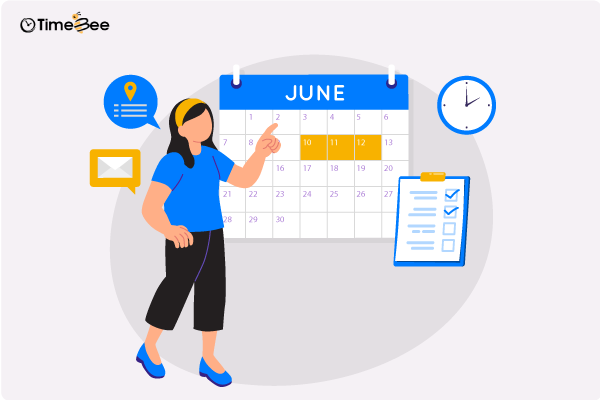Content
Content
Either you run the day, or the day runs you! As a small business owner, you can definitely not afford the latter. Time is your most valuable asset, but managing it effectively and being productive can be a daunting task. And, if you also have to look after your small team, it’ll become even more difficult.
It is where time-tracking for small businesses kicks in as a solution. Not only do you stay on top of your game, but you dictate the time, and it follows your command.
In this blog, we’ll help you turn the tables by debunking the secrets of successful business owners who started small and are doing amazing.
What we’ll discuss:
- What is time-tracking and its 6 methods?
- Why does your business need time tracking to escape the rat race?
- Benefits of time-tracking for small businesses
- How to choose the best time-tracking app for small businesses
- Best practices to implement time tracking
- Overcoming time-tracking challenges for small businesses
In short, this is a complete guide you need to know everything about how to capitalize on your time and boost your business to success. So, remain with us until the end. Let’s dive into the blog without further ado.
What is Time Tracking?
Time tracking, or employee time tracking, is the process of recording an employee’s work hours against their assigned tasks and projects. It ensures employees are fairly compensated and provides employers with insightful data for future decisions.
Time tracking has existed since Egyptian Hammurabi’s code of conduct established a minimum wage for workers based on their time. But in 1888, a New York jeweler invented a time clock that recorded his employees’ work hours and helped him monitor employee productivity, manage project timelines, and allocate resources effectively.
Today, we use different methods of time-tracking. Here are the top 6 methods of time-tracking that have evolved over a period of time.
Top 6 Time-Tracking Methods
Some of the time-tracking practices have become obsolete because of the new technologies. However, these top 6 methods have been popular throughout history.
- Clock-in and clock-out: Employees clock in upon arrival and clock out before leaving work via a physical or virtual clock.
- The Honor System: Employees’ work hours depend on the rule of thumb. Employees report estimated hours they have worked on a project.
- Manual Timesheets: Employees check in and check out manually on paper timesheets.
- Excel Spreadsheet: Employees record and maintain their worked hours on Excel timesheets.
- Manual Timesheet Software: Employees clock in and clock out using software with a manual timer on their computers.
- Automatic Time-Trackers with Timesheets and Workforce Management Features: Employees use an automatic time tracker that records their time, maintains an online timesheet, and evaluates their progress and productivity based on their work.
The most common method that has revolutionized businesses is automatic time-tracking applications like TimeBee. These apps record your time, maintain your timesheets, and help manage projects, budgets, and workforce.
Why Small Businesses Need Time-Tracking?
A simple equation sums up the need for time-tracking:
| Time-Tracking + Smart Work = Productive and Efficient Operations. |
We all know this is the time to work smart. So make the most use of your time by ensuring you are not wasting your valuable hours on unproductive tasks. As the famous Benjamin Franklin says, “Time is Money,” so the more time you waste, the more money you lose.
Time-tracking helps you work smart by identifying areas where you need to save time and adjusting your processes accordingly to maximize your working hours.
Top Benefits of Time-Tracking for Small Businesses
The need for a good time-tracking solution is inevitable. Find some of the greatest benefits your business is missing without having a good time-tracking strategy.
Time Theft Prevention
Any minute that goes by unaccountable is time theft. Many employees manipulate their working hours to increase their billable time. By opting for an automatic time tracker, you can eliminate this issue.
The tracker will track the time and keep the employees accountable for every hour they spend on an assigned project. This will help in meeting deadlines faster and with quality work.
Manage your Projects Better
Even though you are a small business, you might have multiple projects to manage, or you might have to juggle multiple tasks at any given time. In any case, you can opt for an automated time tracker with project management features.
It helps you distribute tasks fairly without causing over-exertion among employees. Plus, it promotes transparent employee-employer relationships.
Maintain Workplace Transparency
A company-wide time tracker keeps everyone informed about the company’s current affairs. This helps build a better workforce and leaves less room for malicious manipulation. Being informed about the company’s current affairs promotes employee loyalty and engagement.
Overall, transparency in the work culture leads to better employee satisfaction and retention, and a strong brand reputation.
Expand Your Team Without Expense
After COVID-19, remote work has become a new norm. It helps businesses save extra time and money by avoiding lengthy and long-term hiring processes. If you start using a time tracker, you can easily manage freelance employees and finish your work.
Plus, by monitoring your remote team’s activities, you can easily evaluate and analyze them. This will help you process accurate payrolls for them.
Keep Your Company’s Data Secure
When you opt for an automatic time tracker with multiple features, such as productivity reports and activity summaries, you are gathering important data that will help you during your audits.
It is important to keep this data safe, and a time tracker with cloud-based backup can easily help you collect the data and secure it for when the time comes.
Now that you know how important a time tracker is for modern business flourishing, learn how to get the best time-tracking software for small businesses.
Top 5 Considerations to Choose the Best Time-Tracking App For Your Small Business
Choosing the right time-tracking app is important to ensure it meets your business’s needs and requirements. Here are the top 5 considerations to keep in mind:

Be Aware of Your Business Needs
Once you buy a time tracker, you must first identify your business needs. Here are some basic questions you must ask yourself:
- Do you need to track time for individual projects or the entire team?
- Do you need to track billable or non-billable hours?
- Do you need a simple time tracker or a comprehensive project management tool?
Answer the following questions to better understand what you need to look for when you go time-tracker shopping.
Opt for an Easy-To-Use Application
When choosing a tracker, make sure it is user-friendly and has an intuitive interface. The features should be easy to navigate, and it should be easy to get started.
If the app is not readily adaptable, it can be counter-productive for your employees, who may resist its implementation. Moreover, a hard-to-use user interface will demotivate workers and increase their stress, resulting in unproductive outcomes.
Check Tracker’s Compatibility
When we talk about compatibility, there are two types of compatibility: one, compatibility with your operating systems, and second, compatibility with your business tools.
So, when opting for a time-tracking solution, don’t only check if it is compatible with Windows and Mac. Also, check if it will connect with your company’s existing tools.
Has Automation Features
In this era of AI and digital boom, it’s better to choose a time tracker with automation features. These features include, but are not limited to, automatic time capture, distraction alerts, automatic screenshots, productivity reports, etc.
Moreover, automation eliminates the room for errors, keeping the record straightforward and accurate.
Customer Support is Easily Available
If you opt for an online time tracker, it can suddenly cause many bugs, and to solve the issue, you’ll need prompt customer support. It will not let your time go in vain. Instead, it’ll help you better grasp the app’s features and functions.
Prompt support saves time and doesn’t stop the work, increasing your team’s productivity and efficiency.
5 Tips to Implement Time Tracking for Employees
Implementing time tracking can be challenging, but these tips can help to make the process smoother and more effective:

Create a Roadmap
When bringing change to your organization, you must create a road map that outlines your goals and objectives by implementing time tracking.
It should include the timelines and milestones for each step. Communicate this map with your employees to ensure everyone is on the same page.
This will also help you identify any roadblocks or challenges you must overcome before introducing a time-tracking solution in your company.
Break down tasks
Huge tasks can become a burden, so it is always better to break them down into achievable chunks. Not only will it help employees manage their time better with a time-tracker, but it will also help you analyze and evaluate your team’s performance.
Involve your employees in the process so that you can identify their working patterns. Encourage them to set goals and plan to easily achieve them by the deadline.
Educate your team:
Educate your team on how time-tracking will help with productivity and better work-life balance.
Be transparent about the goals and objectives that you want to achieve by implementing a time-tracking solution.
This will help them see the bigger picture and understand that it’s not a micro-management tool but a tech-savvy solution to achieve targets within the deadline without causing stress or overwork.
Provide training:
Once you’ve introduced and implemented a time tracker, your next step is to train your employees. Provide them with proper training on using the app and tell them how the app will evaluate their progress and productivity.
If they understand the app better, they’ll be able to overcome challenges more easily. You can use tutorials, training sessions, written guides, checklists, and more as resource material.
Plus, ongoing support will ensure that your team uses the tracker correctly.
Review and Feedback:
After a successful implementation and training, it is important to review the results regularly. This will help you identify issues and areas for improvement and show you how far you have come in your mission.
Have a team meeting and provide detailed feedback to your team. If they aren’t being productive, give them both positive feedback and criticism. This will help them improve and move forward with a better vision.
Overcoming Common Challenges in Time Tracking
Some challenges may occur even if you consider all the considerations and implement the strategy. Here’s how you can cover them:

Outline and Lay Clear Goals.
Know your goals before implementing a time tracker. List your to-dos and prepare a comprehensive plan. This will help you think ahead and avoid wasting your time and money on the wrong time tracker.
Stay Consistent
No matter how long it may take a time tracker to become a norm in your company, don’t let the flow stop. Be consistent with time tracking, and gradually, it will become a habit.
Ask your Team to Avoid Multitasking.
When you assign a project or task to a team member, discourage them from working on multiple tasks simultaneously. No matter how well they can handle it, it’ll hamper your schedule, and when you are implementing the new norms, you need to maintain uniformity.
Settle Privacy and Security Issues
Always be aware of ethical and privacy concerns. Choose a time tracker that complies with the laws and is not unethical. However, if you still feel unsafe, you can double-check the tracker you are using. If there is any issue, you can get your refund and choose a different tracker.
(Pro tip: Always opt for a time-tracker with a refund policy or a free trial so you can test it before implementation to avoid the above issue regarding privacy and security.)
Final Words
Effective time tracking is crucial for small businesses and can be a game changer. We have discussed multiple benefits of a time-tracking solution, such as preventing time theft, managing projects better, maintaining workplace transparency, expanding the team without expense, and keeping the company’s data secure.
So always consider the abovementioned considerations, including opting for an easy-to-use application, checking compatibility, ensuring it comes with automation features, and more.
Moreover, we have reviewed some of the best implementation strategies, including employee training and team education about the new software. We have also identified and laid out solutions for some of the challenges you may face.
In short, we have developed a detailed guide for you that you can also use as a checklist. By adopting time-tracking, you can work smart, use your time better, and boost your business to new heights.
Similar Reading




